Coronavirus: Australian Diamond Princess passengers set to be evacuated as Aussies return from Christmas Island
Australians quarantined on Christmas Island over coronavirus fears have finally put their feet on home soil.
National
Don't miss out on the headlines from National. Followed categories will be added to My News.
- PM extends China travel ban as coronavirus hits Bali
- US navy chief warns China a threat to world order
Most of the Australians quarantined on Christmas Island because of the coronavirus scare will finally wake up in the comfort of their own homes, as about 200 others stranded on a cruise ship prepare to evacuate.
The bulk of people quarantined on Christmas Island flew home on Monday after clearing the 14-day isolation period with no signs of the deadly virus. Melissa Wang, disembarking in Sydney, said she was “feeling so exhausted it’s kind of just a relief”.
She said her experience on the island was “really positive” and she was “very surprised by the care of all the teams”.
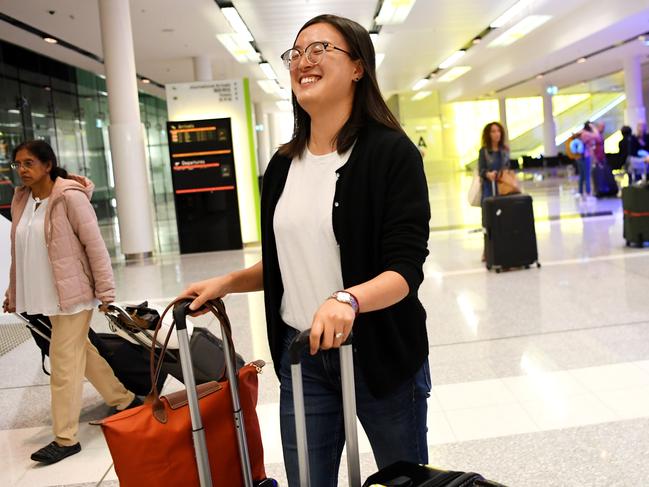

“I was expecting a detention centre, and that’s what it was, but did not expect the warmth of the people,” Ms Wang said.
In Perth, 10-year-old Elizabeth Taylor told reporters she enjoyed “running around, being free (and) seeing all the crabs” but said there were daily health checks too.


Elizabeth said she mostly played sport, including tennis, and did not have to do schoolwork.
About 35 people remain on the island for another flight on Wednesday. None of the people will be required to take further tests after they get home, as they were cleared just before they left the island.


More than 270 Australians were isolated in the island’s detention centre for 14 days in an unprecedented quarantine action to protect the country against the deadly virus.

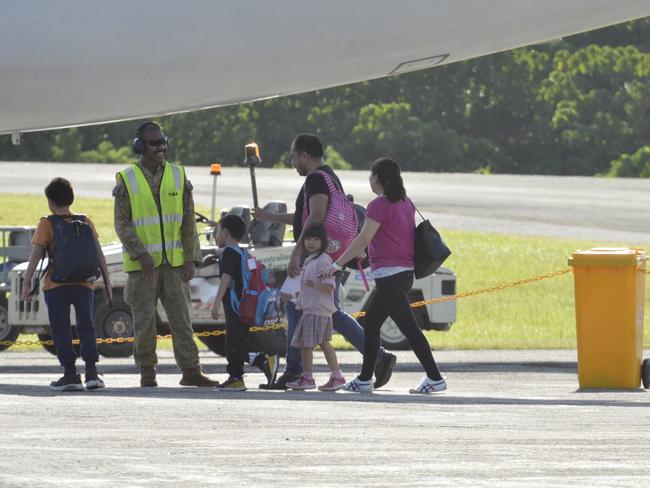
No one in the centre tested positive to the virus, but evacuees will reportedly face a further medical examination before they are transferred back to Australia.
During the two-week stint, three people – including a young girl – were suspected of developing the illness, but tests came back negative.

Three flights are today expected to leave the island, returning the first 241 strong group of evacuees home.
The remaining 36 are expected to be released on Wednesday.
The evacuees were removed from the Chinese province of Hubei, where the virus was first detected.
They were flown to Western Australia on a chartered Qantas flight before being shuttled to the centre on smaller planes where they were greeted by a mural reading “Welcome to Christmas Island” painted by locals.

Three flights are scheduled to depart Christmas Island at two-hourly intervals from 8am today local time.
The first two will refuel at Port Hedland with the first flight then continuing to Sydney and Canberra. The second flight will travel to Adelaide and Melbourne.
A third flight will travel to Perth then on to Brisbane.
The virus, which was recently renamed Covid-19 by the World Health Organisation (WHO), had claimed more than 1600 lives as of Monday morning.
NUMBER OF PEOPLE INFECTED PASSES 70,000
The number of global cases is now over 71,000 - the vast majority are in mainland China, with 99 new cases on the Diamond Princess cruise ship in Japan.
More than 69,000 cases have been reported globally with 15 of those in Australia.
The disease is now bringing China to a virtual standstill.
Nearly 800 million people - or half the population - are now under travel bans or restrictions.
Meanwhile, officials in the coronavirus-ravaged city of Xiaogan have two options — stay at home or face jail time, according to a report.
The city — which is the worst-impacted city after viral ground zero Wuhan — warned residents that they will be subject to 10 days in jail if they break the house arrest, the South China Morning Post reported.
“All urban residents must stay at home and are strictly forbidden from going out,” officials said. “Rural villagers are strictly forbidden from … visiting each other or holding any gatherings.”
More than 2700 cases of the virus have been detected among the 4.8 million residents in Xiaogan, which is located around 50km from Wuhan in Hubei province, the report said.
The death toll in the city reached 70 on Sunday as the ban went into effect at midnight.
The $400 million Christmas Island Immigration Detention Centre has a gym, basketball courts a tennis court and a hockey field, but the facilities were of little use to the evacuees, many of whom chose to stay isolated in their rooms.

MOST ON CHRISTMAS ISLAND CHOSE TO STAY ISOLATED
The $400 million Christmas Island Immigration Detention Centre has a gym, basketball courts a tennis court and a hockey field, but the facilities were of little use to the evacuees, many of whom chose to stay isolated in their rooms.
Photos showed small groups of adults and children stretching their legs in the sunshine and kicking around a soccer ball while wearing white face masks which they were required to use in communal areas.
Those quarantined were subjected to frequent temperature checks by Australian Medical Assistance Team members in a bid to catch any warning signs on the virus.
Fever is a common symptom of Covid-19, as well as breathing difficulties, headaches, sneezing, coughing and fatigue.
Reports emerged from evacuees that some were concerned about the standard of hygiene in the centre after a cockroach was discovered in one of the rooms, complaints were also made about the slow internet connection.
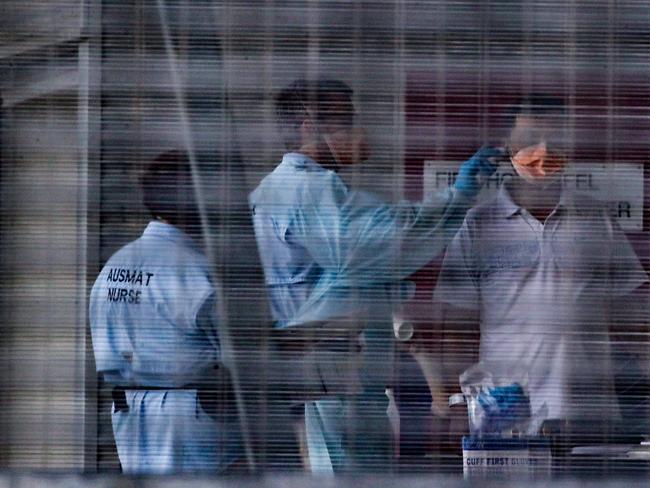
These complaints were ridiculed in a closed Facebook group where Christmas Island locals called the evacuees “ungrateful”.
“Has any CI resident been able to contain cockroaches? Welcome to the real world, not just Christmas Island. Were they expecting a four-star resort? Just imagine the cost and effort involved and the logistical nightmare in bringing them here,” Sharon Tisdale wrote on the CI Blackboard page.
Travel restrictions will remain in place for people travelling from mainland China until at least February 22.
The Department of Home Affairs has advised entry to Australia will be denied to travellers unless they are Australian citizens or residents, New Zealand citizens who live in Australia, or immediate family members of Australian citizens and residents.
Aussies ‘kept in dark’ on ship amid new virus theory
An exhausted Melbourne woman stuck on a coronavirus-infected cruise ship in Japan says Australian passengers are being kept in the dark about the government’s plans for them.
Vera Koslova-Fu has pleaded with the federal government to reveal if they will remove Australians from the Diamond Princess and force them into a new period of quarantine once they are back home.
She has raised the prospect of people refusing to join any Australian evacuation, in the hope they can leave the ship as early as Friday when their existing quarantine period expires.
“There’s been some chatter about people not leaving, if we are being evacuated,” Ms Koslova-Fu told ABC television today, hours after the US took its citizens off the ship.
She said Canada and Hong Kong were doing the same, and that all those groups apparently faced a further 14 days of quarantine post-evacuation.

But she questioned why people like her – who have so far tested negative for coronavirus – should have to endure that.
“(Does) having a negative result mean nothing? Is it because the Australian government doubt Japan’s testing ability?”
She said she was relying on news reports and journalists in Tokyo and Australia for information, and that in recent days the flow of information to passengers had been “very delayed”.
“We just feel like we’re kept in the dark,” she said.
She said the ship’s captain had been doing his best when he was “allowed” to share information, including that those who continue to return negative test results can get off the ship as early as Friday.
“We will be allowed, if it is a negative result, we will be allowed to disembark and they are organising disembarkment process as well as ways to get us home.
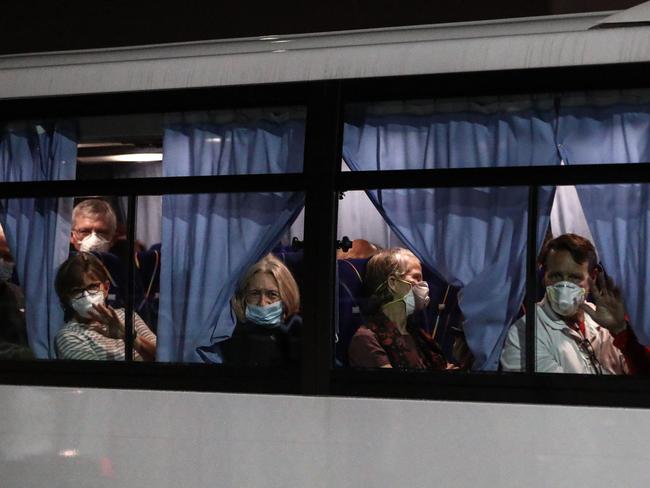
“I don’t want to go to another facility to be quarantined for 14 days if I am tested negative. You need to tell me why I need to have a further 14 days of quarantine if I am tested negative?”
An Australian infectious disease expert is in Japan assessing the situation on board the ship.
About 200 Australians are on the ship, which has been in quarantine in the port of Yokohama for more than two weeks.
Seventy more people on board were confirmed to have the virus on Sunday, bringing the number of cases from the ship to 355, with 16 of them Australians.
Those who tested positive for the virus are being treated in Japan.
The Australian reported that Prime Minister Scott Morrison and cabinet are waiting for a medical officer in Japan to make a full assessment of the situation on the Diamond Princess before they proceed with an evacuation.

Evacuated Australians are expected to be taken to the workers village near Darwin.
Meanwhile, the NSW government announced that passengers arriving into Sydney on some cruise ships will be assessed by health experts for coronavirus to prevent the spread of the disease.
NSW Health said a risk assessment will be completed before each ship’s arrival into the harbour city and then a decision will be made on whether to disembark passengers from the ship.
The health authority insists it is a precautionary measure to prevent the spread of coronavirus.
The testing process will be similar to the assessments being done for passengers arriving at Sydney airport.
NEW THEORY ON WHERE CORONAVIRUS STARTED
Scientists believe they know what ignited the new coronavirus that has claimed more than 1700 lives and infected more than 68,000 people worldwide.
Up until now researches had not pinpointed exactly how the newly named Covid-19 first infected people.
Evidence has previously suggested it originated in bats, which infected another animal that spread it to people at the now closed Huanan Seafood Wholesale Market in the southeastern city of Wuhan.
Now scientists believe that the Wuhan Centre for Disease and Control and Prevention was the possible source because it “hosted animals in laboratories for research purposes”, including bats, and was “within 280 metres of the market”.
The research centre was also next to the Union Hospital where the first group of doctors was infected.
In the paper, titled The possible origins of 2019-nCoV coronavirus, the researchers reveal tissue samples were regularly extracted from the bats.

On one occasion, a worker at the WCDCP was “once attacked by bats and the blood of a bat (was) shot on his skin”, scientists from South China University of Technology in Guangzhou said.
“He knew the extreme danger of the infection so he quarantined himself for 14 days,” the scientists wrote.
“In another accident, he quarantined himself again because bats (urinated) on him.”
A second lab, the Wuhan Institute of Virology, Chinese Academy of Sciences, was 12km from the seafood market. Bats were used for research purposes there too.
The scientists wrote that the institute reported that Chinese horseshoe bats were natural reservoirs for the SARS virus that caused the 2002 pandemic and that “somebody was entangled with the evolution of 2019-nCoV coronavirus”.
CHINA CALLS FOR END TO ‘HARSH’ TRAVEL BAN
China’s ambassador to Australia Cheng Jingye has called on Australia to remove “harsh” travel ban restrictions in the wake of the deadly coronavirus outbreak.
In an exclusive interview with Sky News chief anchor Kieran Gilbert, Mr Cheng said the travel ban “unnecessarily” interfered with trade and travel and said Australia should be “coolheaded and not panic”.
“We are deeply disappointed by the restrictive measures that have been taken because as I see it they are out of proportion,” he said.
“As you said it is inconsistent with the professional recommendations of the World Health Organisation.
“We have expressed our strong wish and hope that the Australian government in its next review will take into account the whole situation and take a balanced approach and consider removing those harsh restrictions or at least relax restrictions.”
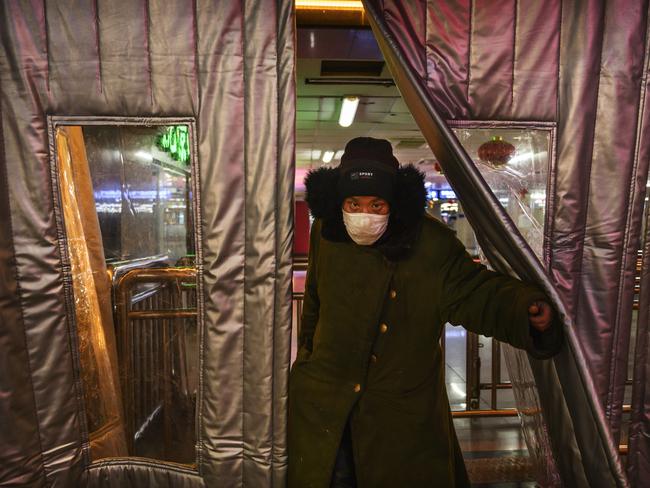
Mr Gilbert pointed out that China itself had taken extraordinary measures well beyond recommendations of the WHO by detaining millions of people in Wuhan and the broader Hubei province.
Mr Cheng responded saying the situation in China was “totally different” from that in Australia.
“We need to take extra measures to stop the spread of the disease whereas here the situation is totally different,” he said.
“Australia is only one of a few countries which has taken such sweeping and stringent restrictive measures on travel.
“We hope the (Australian) government will take a balanced approach and remove harsh restrictions or at least relax them.”
MAN DIES IN TAIWAN – WITH NO HISTORY OF VISITING CHINA
Taiwan has recorded its first case of coronavirus, a man with no known history of travel to mainland China.
The 61-year-old had a history of diabetes and hepatitis B.
Health officials are still determining how he might have been infected.
He worked as a taxi driver and may have contracted the virus from a passenger.
The man’s housemate, a relative of the infected man aged in his 50s, was also infected, according to health officials.
Taiwan has now recorded 20 new cases of coronavirus and has enforced stringent limits on travel from the mainland to prevent further spread.
EMBASSY EMAILS AUSSIES STRANDED ON SHIP
Earlier, it emerged that the Australian Embassy in Tokyo had sent an email letter to passengers saying they were examining options to assist the more than 200 Aussie passengers on board.
France reported Europe’s first death from the new virus, a Chinese tourist from Hubei province, where the disease emerged in December. It is the first death outside Asia.
The letter from the Australian Embassy in Tokyo says: “You may have already seen the news that the US Government is planning to assist US passengers on the Diamond Princess to return to the United States in the coming days.

“We understand the US Embassy will send out information to US passengers on the ship about their plans shortly. The Australian Government is also examining options to assist Australians on board the ship. We will contact you again as soon as any decision is taken.
“We understand this is a very stressful situation for you on the ship. Please be assured we are working hard to assist all Australian passengers and your welfare is our paramount concern.”
Australian medical officers are working closely with the Japanese authorities and the health representatives of other countries, it said.

NSW TO RAMP UP VIRUS TESTING ON CRUISE SHIPS
Passengers arriving into Sydney on some cruise ships will be assessed by health experts for coronavirus to prevent the spread of the disease.
NSW Health on Sunday said a risk assessment will be completed before each ship’s arrival into the Harbour City and then a decision will be made on whether to disembark passengers from the ship.
The health authority insists it is a precautionary measure to prevent the spread of Covid-19.
The testing process will be similar to the assessments being done for passengers arriving at Sydney airport.
Passengers arriving in Sydney aboard the Maasdam cruise ship from New Zealand on Sunday were assessed as a “safeguard,” with NSW Health confirming no one had symptoms of coronavirus and none required testing for the virus.

NSW Health said there are thousands of passengers, including the elderly, on cruise ships and they often require medical management for unrelated infectious diseases while on the cruise or when they disembark.
One person on board the Norwegian Jewel was tested on Friday and cleared of the virus during a precautionary assessment.
The ship, which arrived in Sydney on Friday and was scheduled to depart on Saturday for a 14-day cruise of Australia and New Zealand, was never locked down.
The ship’s owner slammed “false and inflammatory” media reports which suggested someone on board could have contracted the disease.
MELBOURNE DOCTOR URGES AUSSIE ACTION
Melbourne woman Dr Erika Cretney, whose father Edgar Krasovskis was on Wednesday diagnosed with coronavirus, backed Australia sending a plane to retrieve stranded passengers from the Diamond Princess, including her mother.
Mr Krasovskis was in a Japanese hospital but Dr Cretney said there was no reason why her mum Lana, 68, who was still on the cruise liner, couldn’t serve out her quarantine back home.
To make matters worse passengers had just been told those in contact with someone infected would need to restart their 14 days of isolation from the day of diagnosis.
“I think it’s a great idea if they would be able to bring everyone home,’’ Dr Cretney said.
“If Australia was willing to bring her back she could then sit it all out back home.
“The would be great.”
Melbourne retirees Adina and Les Morris said while they were happy to serve out their remaining days of isolation on the ship a government-organised flight was needed.
“They should get us out of here on a plane’’ Mrs Morris said.
“Definitely the Australian government should send us home ASAP.”

The thousands of people who were stranded tried to make themselves useful and keep busy, including some Trump supporters who hung up a banner outside their cabin.
FRENCH DEATH FIRST OUTSIDE ASIA
An elderly Chinese tourist hospitalised in France has died after infection with the coronavirus, becoming the first fatality in Europe, French Health Minister Agnes Buzyn said.
Until the death in France, there had been three deaths outside China, with one in Japan, one in Hong Kong and one in the Philippines.

Buzyn said the 80-year old man, who had been treated at the Bichat hospital in northern Paris since January 25, had died of a lung infection due to the coronavirus.
The man was from the Chinese province of Hubei, the centre of the coronavirus outbreak, she said. He had arrived in France on January 16 and was hospitalised on January 25 and put in isolation. His condition deteriorated rapidly.
His daughter was also hospitalised, but authorities say she is expected to recover.
Europe has 46 cases of the virus that first emerged in central China in December. Nine European nations have reported cases, with Germany having the most at 16. France has recorded 11 cases of the virus.

AUSTRALIAN HEALTH OFFICIAL TO JOIN GLOBAL TEAM IN JAPAN
Australia’s public health officer was expected to arrive in Japan on Sunday to help authorities.
Deputy Chief Medical Officer Paul Kelly said the infectious disease expert will join an international team to gather information about the passengers, including the 200 Australians on board.

“We will have someone on the ground as early as tomorrow morning,” Professor Kelly told reporters in Canberra on Saturday.
“We will be looking at the health and welfare of that group and what might be best done with a view to getting them off the ship.” There are reports that the US intends to get its citizens off the ship and take them home.
“We wait for our expert to be on the ground to assess what is the best option for those Australians,” Prof Kelly said.

The Japanese government slapped a two-week quarantine order on the Diamond Princess on Wednesday last week when it became apparent there was an outbreak on board.
As the illness spreads, the Australian Ambassador to Japan, former Western Australia premier Richard Court, has reached out by email to those caught up in the Diamond Princess situation.
“I want you to know your Government, through the Embassy in Tokyo, is totally committed to your welfare and safety,” he wrote.
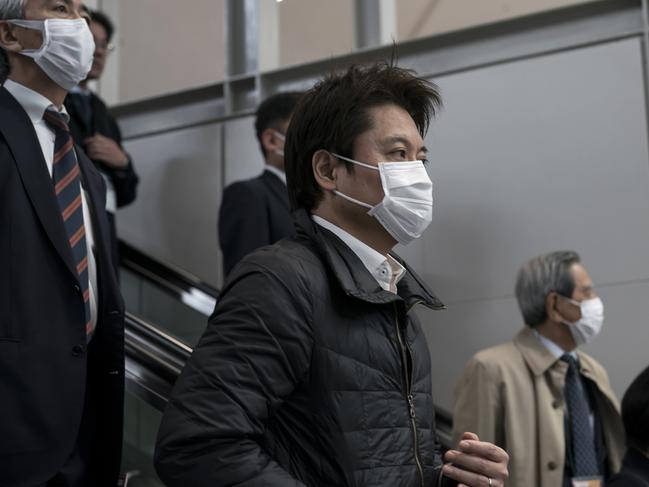
Mr Court explained the focus of embassy-led efforts was to ensure the Australians on board were receiving the medical care and the prescription medicine they needed.
For those in hospital, progress was “encouraging”.
He added that his team is seeking urgent clarification from the Japanese government and the cruise operator about what will happen to passengers once the quarantine period ends.
As the lockdown drags on for the confined passengers, the Australian government and Princess Cruises are offering telephone counselling services.
CHINA’S NEW QUARANTINE POLICY
China has established a new quarantine policy as its gymnastics team was forced to pull out of the World Cup being held in Melbourne. More than 67,000 now have the virus as the worst is yet to come.
The gymnastics team entered into next week’s World Cup in Melbourne pulled out due to Australian government travel restrictions put in place to limit the coronavirus outbreak, organisers said on Saturday.
The restrictions on foreign nationals travelling from China were introduced in early February and extended for another week on Thursday.
The extension effectively rules out China’s participation at the February 20-23 World Cup, which offers qualifying points for this year’s Tokyo Olympics.
“It has been a very challenging few weeks for us all, but none more so than for the Chinese gymnasts and officials who have been training and preparing to come to Melbourne,”

Gymnastics Australia CEO Kitty Chiller said in a statement.
“I have been in regular contact with the Chinese Gymnastics Association and its President, who informs me all of their delegation are well and have shown no sign of infection.” “Despite this, we all have to respect the Australian government’s travel restrictions.”
Among the 12 Chinese entries listed on the World Cup’s website are four-times world champion Zhang Chenglong, who claimed the men’s team gold at the 2012 London Olympics and bronze at the Rio Games.
Zhang’s Rio teammates You Hao and Liu Yang will also miss out, along with Xiao Ruoteng, a former men’s all-round world champion.
MORE GLOBAL TESTING, CRUISE SHIP DOCKS
The US announced its major cities will begin routinely testing anyone with “flu-like symptoms” for the coronavirus as it was confirmed the first case had reached the African continent.
A senior US health official confirmed testing will commence in New York, Los Angeles, San Francisco, Seattle and Chicago — meaning many millions of tests are likely to be conducted.
“CDC (Centers for Disease Control and Prevention) has begun working with five public health labs across the US to tap into their ability to conduct community based influenza surveillance, so that we can begin testing people with flu-like symptoms for novel coronavirus,” said Nancy Messonnier, a senior CDC official.
More sites are planned to be included in the testing regime.
Meanwhile, Egypt’s health ministry confirmed its first case of the novel coronavirus, making it the first in Africa.
The nationality of the person was not given in the joint statement with the population ministry, which added that they had shown no “symptoms”.
Authorities have notified the World Health Organisation and the patient has been placed in isolation in a hospital for treatment and monitoring.

After two weeks of being stranded on the MS Westerdam cruise ship over coronavirus fears, 1500 passengers were greeted with roses by the Cambodian Prime Minister when the ship finally docked in the port of Sihanoukville on the country’s eastern coast.

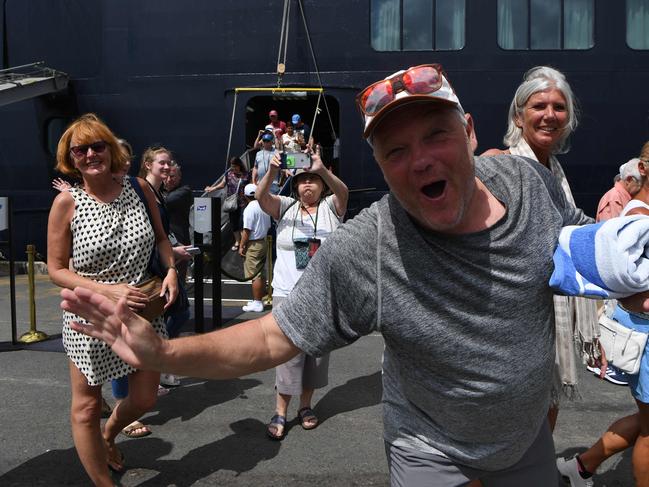
But an 83-year-old US woman who was a passenger on the ship has tested positive for coronavirus.
The American woman flew to Malaysia on Friday from Cambodia along with 144 others from the ship, the Malaysian health ministry said in a statement.
The woman’s husband had tested negative, the ministry said on Saturday.
The MS Westerdam docked in Cambodia after being shunned by five countries on fears that passengers could be carrying the virus.
The 1455 passengers and 802 crew had spent two weeks at sea and were tested regularly on board. Cambodia also tested 20 once it docked.
PLANES IN LOCKDOWN AT HEATHROW
In other developments, coronavirus fears sparked a lockdown of eight planes at Heathrow Airport Friday morning — including a flight from California — after passengers complained they were suffering from symptoms, according to new reports.

Passengers on United Airlines Flight 901 from San Francisco were told by the captain to stay put after landing because someone on board might be infected, The Daily Mail reported.
British passenger Andy West told the outlet the captain said they might not move for a while because “seven other planes” had suspected cases as well.

Further details involving the other aircraft are unknown. Heathrow Airport declined to comment but is believed to be running as normal with all runways open.
Staff on the morning United Airlines flight — none of whom were wearing protective gear — brought the passenger to the back of the plane and waited for health officials to arrive in hazmat suits, West said. Everyone was allowed off the flight about half-an-hour later.
HEALTH EXPERTS SAY ‘WORST STILL TO COME’
Health researchers in the UK believe the peak in coronavirus infections in Wuhan may not be until the end of February.
And it comes as 1716 health workers in China have been infected by the coronavirus and six of them have died, as of Tuesday.
China National Health Commission Vice Minister Zeng Yixin, at a press conference about protecting medical workers, said the number of infected medical staff is increasing.
Chinese officials and hospitals have repeatedly noted a shortage of protective equipment, including face masks, as the disease took hold in Hubei and spread throughout the country.
China reported 2,641 new virus cases Saturday as it escalates measures to contain the outbreak and reassure an anxious public.
The figure is a major drop from the higher numbers in recent days since a broader diagnostic method was implemented.
The number of new deaths rose slightly to 143, bringing the total fatalities in mainland China to 1,523. The number of confirmed cases in the country now stands at 66,492, according to China’s National Health Commission.
On Thursday a huge spike in new cases – 14,800 in a single day – prompted alarm, but the increase was attributed to a new clinical definition.
Whereas previously cases had only been confirmed once laboratory tests had been carried out, from Thursday China started counting new cases as those that had been clinically diagnosed.

A team from the London School of Hygiene and Tropical Medicine (LSHTM) used dataset modelling this week to forecast the probable trajectory of coronavirus within Wuhan, and estimated that the virus would peak somewhere between mid and late February.
A key factor in the modelling is the reproduction number (R0) of the virus, defined as the average number of people who will catch the disease from a single infected person if they have never been exposed to it before. In their modelling, the LSHTM team stated that prior to January 23, when travel restrictions were imposed on Wuhan, that number varied between 1.5 and 4.5.

Another modelling study published in The Lancet on January 31 estimated the reproduction number of coronavirus to be 2.68.
By way of comparison, regular influenza has a reproduction number of two to three, and measles has a reproduction number of between 12 and 18.
But Raina Macintyre, Professor of Global Biosecurity at the University of NSW’s Kirby Institute, said that the LSHTM modelling, and other studies done so far, were based on inadequate data.
“A lot of (the studies) use the date of reported cases. You need to get data on symptom onset date. The best estimates need to have that kind of data. Without that there is a lot of uncertainty,” she said.

The health system in Wuhan was under incredible stress, new cases were being reported in batches, and there was a significant amount of undereporting of cases, Prof Macintyre said – all of which created “a lot of uncertainty in the estimates”.
One study that had been done using symptom onset data suggested coronavirus had a reproduction number of 2.2, so that was the “best estimate” we have to date, Prof Macintyre said.
“Coronavirus could become a pandemic, but there is still a prospect to stop that from happening,” she said. “Travel restrictions have really reduced the cases in other countries and we have benefited from that.”
Professor Rowland Kao from the University of Edinburgh said the limitations of the data used in the LSHTM modelling – which has as yet not been peer-reviewed – would affect predictions of the virus’s likely trajectory.
“The predictions for the outbreak peaking in Wuhan implies that, by whatever means, the number of new cases will start to decline – it does not imply that the disease is necessarily under control. If previously unexposed populations become infected, the outbreak could start rising again,” he said.
– with AAP and Reuters
Originally published as Coronavirus: Australian Diamond Princess passengers set to be evacuated as Aussies return from Christmas Island
